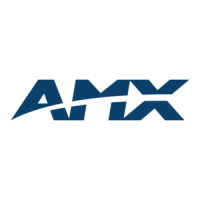NetLinx Programming Overview
29
NetLinx Programming Language Reference Guide
COMBINE_LEVELS (<virtual DEVLEV>, <DEVLEV1>, <DEVLEV2>…)
UNCOMBINE_LEVELS (<virtual DEVLEV>)
DEVLEV structures defined within the COMBINE_LEVELS are either individual DEVLEV structures or
one dimension of a
DEVLEV array. Any reference to the levels is handled through the first device in the
list.
Combining and uncombining channels
Combining DEVCHANs is unique to NetLinx. The NetLinx function COMBINE_CHANNELS combines an
individual channel on a virtual device to one or more channels on another device (or devices). The
format for
COMBINE_CHANNELS and UNCOMBINE_CHANNELS is:
COMBINE_CHANNELS (<virtual DEVCHAN>, <DEVCHAN1[]>, <DEVCHAN2[]>…)
UNCOMBINE_CHANNELS (<virtual DEVCHAN>)
String Comparisons
While in Axcess it is possible to perform a string comparison using the '?' wildcard, Netlinx requires the
COMPARE_STRING function to be used instead.
Axcess code - string comparison
IF (TIME = '12:00:??')
(* Do something at noon - evaluation is valid for an entire minute *)
Netlinx code - string comparison
IF (COMPARE_STRING(TIME,''12:00:??'))
// Do something at noon - evaluation is valid for an entire minute
Modules
There are two ways to reuse code in different Axcess programs: Include Files and System Calls.
Include files redirect the compiler to files with an .AXI extension. The .AXI files can contain
the same type of information present within an Axcess program. All data is accessible both
within the Include file and within the primary Axcess program. Include files are limited
because they are static. Mainline statements within the Include file cannot be adapted from
program to program without altering the Include file. To update the Include files in a program,
the entire program must be compiled and loaded.
System calls are external subroutines that can be instanced and referenced in the main
program. Like
DEFINE_CALL subroutines, System Calls can pass parameters to adapt the
System Call to the needs of different programs. System Calls have been one of the primary
tools for creating standardized reusable blocks of code. To update the System Calls within a
program, the entire program must be compiled and loaded.
Modules are unique to NetLinx. Like Include files, the code within the Module is not limited to the
DEFINE_CALL section. Modules can contain variable definitions, functions, subroutines, startup code,
events, and mainline. Modules are passed parameters that are used to adapt the information and variables
used within the Module (similar to System calls).
Modules are similar to programs loaded into AXB-232++ boxes. They operate as stand-alone programs
inside the NetLinx program. Interaction between the Module and the NetLinx Program is done through
User Interface (UI) pushes and releases, turning virtual device channels on and off, and passing variables
and arrays to the Module. The code in the Module is local, or is restricted to use only within the Module.
This means that functions and subroutines defined with Module cannot be directly used with the main
NetLinx code.

